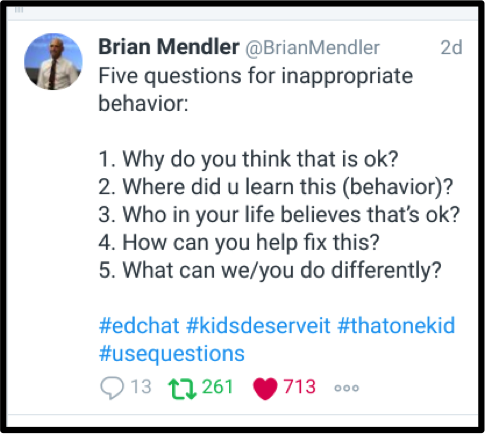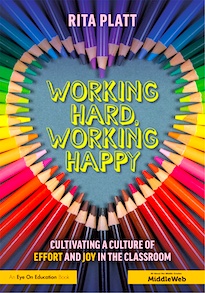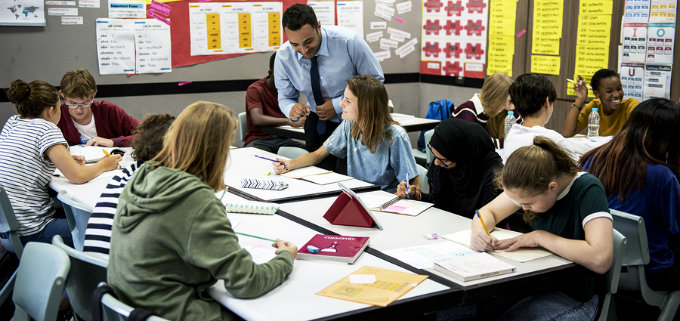10 Tips to Maintain Positive Student Behavior
A MiddleWeb Blog
 The honeymoon is over. Or, at least, if you’re like many teachers, it feels that way. Depending on where you live, you’re 6-8 weeks into the school year. You’re probably tired and the students in your care are probably beginning to make more poor choices than they did in those first blissful few weeks you were together.
The honeymoon is over. Or, at least, if you’re like many teachers, it feels that way. Depending on where you live, you’re 6-8 weeks into the school year. You’re probably tired and the students in your care are probably beginning to make more poor choices than they did in those first blissful few weeks you were together.
Don’t worry, it’s normal. In fact, it’s so normal that one of my favorite teacher bloggers, Love,Teach, has coined the acronym, DEVOLSON (The Dark, Evil Vortex of Late September, October and November) to describe how hard this season of the year can be.
One way to fight the pain of DEVOLSON is to refresh your systems for maintaining positive behavior in your classroom so that the hum of learning continues to sound sweet.
Ten Tips, Hints, and Reminders
1. When students misbehave, they are communicating with us. This is especially true for our “frequent fliers” – those kiddos who seem to test us all a great deal of the time. Try to listen. Get to the bottom of the need they are trying to meet. Is the student seeking attention? A sense of control? A release from fear of failure? Once you identify the need, you can work to proactively ward off poor behavior.
For more on identifying the need behind the behavior, order a copy of Cooperative Discipline by LInda Albert or read the series of short articles from Michigan State University. For strategies to be proactive in helping your students behave well, check out the PBIS World interactive page to find targeted strategies to promote good behavior (just click on your current issue!).
2. Misbehavior is an opportunity to teach. That’s a good thing! That’s what we do! The kids in our classes are going to run the world when we’re old. We need to help them learn strong character traits such as respect, cooperation, assertion, empathy, and self-control. It may be hard but it will pay off for all of us in the long run. Nina Parish says it well in her Edutopia blog post,
“I found that thinking about behavior objectively, as a skill to be taught rather than simply as good or bad, was immensely helpful… Some children enter school without the self-regulation skills necessary for school success. We must meet these children where they are and teach them the skills they need to be successful in the classroom.”
3. There is no point in thinking, “She should know better!” or saying, “I already taught that!” Kids do not yet have a fully developed prefrontal cortex; even if they wanted to always make good choices, it likely wouldn’t be possible. We must model, reteach, and hold students accountable to the rules and values of the classroom.
This means developing consistent routines and procedures, modeling them, reteaching them often, and problem-solving with your class as a whole or individual students when needed. Angela Watson offers sage advice here, and seventh grade social studies teacher Stacey Belisle shares her method for collaborating to create and maintain rules and expectations here.
4. There is no shame in needing help. If you feel like you can’t get through to your entire class or to a particular kid or two, reach out and ask for help. There is someone in your school who is good at and loves to work on ameliorating negative behaviors in students.
Watch an expert classroom manager in action, reach out to your principal, or get in touch with your school’s behavior management/school improvement team, or your PLC. There is not going to be a panacea for every misbehavior, but you are more likely to find answers through collaboration than completely on your own.
5. Always remember that you deserve to be respected. Not only because you are a teacher but because you are a person. Enough said. If students are not showing you respect, demand it. The Power of Positivity blog can help you change the way you think and act so that you command respect.

Set 1: What are you doing? What SHOULD you be doing? Will you please do that right now?
Set 2: Why do you think that is okay? Where did you learn to behave like that? Who in your life believes acting like that is okay? Can you stop behaving like that now, please?
7. The bottom line in classroom management and effective discipline is relationships! When we know our students as people and they know us, they are less likely to misbehave. Greet students in the halls and outside of your classroom. Get out in the community. Call, text, or email your students’ families with good news or to share something interesting or funny they said. Reaching out to families for positive communication shows you truly care. Read about the power of a positive phone call.

I remarked, “Wow, Penny! These are the best tomatoes ever! They are firm and sweet!” Without missing a beat, Penny replied, “Yes! Firm and sweet, just like your discipline style and mine!” The point? Be a tomato! If there is a dichotomy between the descriptors firm and sweet, it’s a false one.
9. Avoid giving your power away. While many principals (especially me!) are happy to collaborate, beware of using your administrator as a scare tactic (i.e.: If you do that again, I am going to send you to Mrs. Platt’s office).
When the principal is viewed as a threat, there may be two unintended negative consequences. 1.) The office becomes a bad place. 2.) Students learn that the teacher is not the ultimate boss of them. Make sure kids know that YOU are in charge of your classroom. Read more on that concept in Jennifer Gonzalez’ enlightening Cult of Pedagogy post.
10. HAVE FUN! LOTS OF FUN! Play, laugh, and dance with your kiddos! Whenever possible, incorporate games, jokes, and music into your lessons. Students who are happy are more open to learning, and that’s the big picture goal, right?
Keep the mood of your classroom positive. When you feel like you might be getting frustrated or even angry with your class, step back and get your emotions under control. Read about strategies for keeping your classroom fun and even for using fun to teach discipline. Just as important, find strategies to keep yourself from losing your cool.
The Bottom Line
Educators, the truth is that without an orderly classroom where students understand and respect the rules, procedures, and expectations, teaching and learning are much harder endeavors. Yes, the meme to the right is, in part, true, but so is everything I shared above. Lead your classroom with heart and with smart tried-and-true strategies.
If you are interested in further reading, check out my recent post for Heart of the School. If you want a laugh, check out Principal Gerry Brooks’ videos on the essentials of classroom management. Funny stuff and some good advice too!
As always, I am interested in your thoughts. What are your best reminders, hints, and tips for classroom management? Please share in the comments. We’re ALL better when we share ideas and collaborate!
___________________________________






































Excellent!!!
Thank you!
The tips you share apply to older students as well. An engaging lesson plan is indeed a key to engaging and sustaining an audience. To this end, I recommend two practices.
1. Stick to an age = minutes of attention span approach to activity duration without a break or a shift. A 13 year old student? Plan for up to 13 minutes of focus if the activity is student-centered and engaging. Then build in a transition or shift to a different mode to continue the learning.
2. Let students plan lessons too. Deviant behaviors are less likely to surface during lessons students themselves create. When investors plan, they work to see it through.
Ideas like these are on my blog: jmhayward.edublogs.org.
I am happy to have found your blog, Rita. Thank you!
YES! I love the age = minutes rule of thumb! In fact, I would add that even after kiddos are 10, use a 10 by 2 rule. No more than 10 minutes of teacher talk. After every 10 minutes allow a minimum of 2 minutes for students to interact.
Very much needed for my teachers. Thank you
Great!
While I agree with most of what is said here, I am skeptical about a few things. I work in an alternative school, this is their second and maybe third chance and we know that they will make mistakes here as well. We strongly agree that people can learn from their mistakes so having them reflect is a wonderful way to do so.
As for the five questions for inappropriate behavior; I see them as looking for someone to blame. We know that some of their inappropriate behavior comes from home or the people with whom the students spend most time. Here are a few questions that we ask students: 1. What happened? (allow the student to give his/her perspective of the event)
2. Why did you do ______?
3. What outcomes did you believe you would get?
4. What could you have done differently?
5. What would have been the outcome if you had _____?
Most inappropriate behavior can be accredited to students’ emotions. I believe it is important to remind them that if they allow someone to push their buttons, it means that they are not in control of their emotions and if they cannot manage their emotions, someone else will manage it for them.
I like your questions too. However, I don’t think the other set is looking for blame. In fact, in almost every case, the kids answer that NO ONE at their house would think their behavior is okay.
Thanks so much for the great feedback!
SPOT ON!, Mrs. Platt. I’m publishing a new book on November 2 for SafeSchools Law Advisory Group that deals with the legal aspect of many points you raised. When schools and police are accused on not having done enough to protect students, the questions you cover are part of the liability discussion. Rather than risk an adverse binding precedent, risk, insurance and litigation managers choose to settle under a “the parties do not admit negligence” type of agreement. My group has been asking point questions and analyzing settlement discussions ever since Columbine. Our conclusion is that failure to intervene in negative behavior situations long before tragedy occurs is a ticking liability time bomb. Check back with me at safeschoolslaw@gmail.com if you would like to contribute your thoughts. Gary Avery, J.D.,
Interesting! Thanks for reaching out!
I find some of these suggestions extremely troubling and expressed in a voice of privilege, based on a power dominant cultural context. I’m agreeing with MH. “Where did you learn to behave like that? Who in your life believes acting like that is okay?” What if a child learned from a drunk Uncle, a troubled sister, a mostly absent parent? Do you really expect student relationships to grow, to open and then answer with their truth? Even reading the tone feels like finger pointing. I suggest beginning with 1) Tell me, in your own words, what happened? 2) What happened even before that? 3) What were the results. 4) Here’s what I observed and so on.
Phyllis, I like your questions too!
Thanks! Great article!
Thank you!
I totally recommend Smart Classroom Management as a great resource for all classroom management needs! It’s kind of anti-PBIS (which I think is better for very specific students, but not the general room), but it’s still positive and affirming for kids.
What strategies can you offer Substitute Teachers? Unfortunately, we don’t have as much time to take advantage of the ideas you share here.
I love the acronym DEVOLSON. It is so true that behaviors kick in around October. This article was great! I will keep in mind that when students misbehave they are communicating something. I will try harder to find out what they need. I also need to remember that I need to constantly model and reteach rules and values. I will work harder to establish relationships and support students outside of the classroom. Maybe I will go to a sporting event this year.
For number 8, “be a tomato” is unhelpful. Can I have concrete examples please?
Yes!!! I’m not sure how many times I hear this in a year… “There is no point in thinking, ‘She should know better!’ “